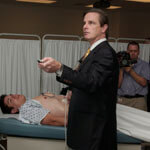
Learning the organs and systems of the human body on a computer screen instead of peering down a microscope … “flying around” an organ to see it from all vantage points … interpreting the squiggles and lines of an ultrasound examination on a portable screen … using keystrokes to control treatment after a simulated patient faints in a dental chair.
These are just some of the amazing examples of technology, funded by a $5 million, 10-year grant from the SBC Foundation, that are being integrated into the educational curriculum of The University of Texas Health Science Center at San Antonio.
Francisco G. Cigarroa, M.D., president of the Health Science Center, welcomed John T. Montford, SBC senior vice president, Sens. Jeff Wentworth and Leticia Van de Putte, Art Hall, District 8 San Antonio City Councilman, and other dignitaries Oct. 12 for a demonstration of six technologies made available to the Health Science Center through the SBC Foundation grant. This is one of the Foundation’s largest grant awards.
“It is a rare opportunity to receive a gift that touches every aspect of our mission, and I’m proud to say this one does,” said President Cigarroa, a practicing pediatric and transplant surgeon. “The SBC Foundation is enabling us to create an enriched academic environment that will continue to attract the best and brightest faculty and students. We greatly appreciate the Foundation’s commitment and trust.”
The SBC grant began in 1999 with a “virtual campus” initiative that greatly improved the Health Science Center’s connectivity and infrastructure, including construction of the SBC Teleconference Center at the Texas Research Park. “We are proud to have played a role in the Health Science Center’s development, and we are glad to be a part of these new projects to augment the preparation of health care professionals and scientists,” Mr. Montford said.

The SBC Foundation grant is supporting a dozen faculty projects – six of which were demonstrated Oct. 12. The projects and faculty leads are:
• “Teaching Medical Students to Use Portable Ultrasound Imaging,” Gerald Dodd III, M.D.
• “Virtual Microscopy for the Health Professional,” Tom King, Ph.D., Frank Weaker, Ph.D., Nan Clare, M.D.
• “Computer Simulations of Medical Emergencies in the Dental Office,” Ernest Valdez, D.D.S.
• “Healthy Texas/Go Local Gateway,” Mary Moore, Ph.D.
• “GATEways (Gross Anatomy Teaching Enhancement),” Patricia Brewer, Ph.D.
• “Virtual Anatomy Project,” Michael Freckleton, M.D.
“The Health Science Center is the jewel of our community,” Sen. Van de Putte said. “Anything that we put into it is worth every penny.”
Two initiatives are the anatomy and gross anatomy simulation projects. The virtual anatomy program enables computer users to rotate body structures 360 degrees in real time so that they can see the relationships of skin, bone, muscle and other structures much more clearly.
The new simulations enable greater visualization of both parts of this educational process.
A portable ultrasound technology extends ultrasound capability to home health care, the battlefield and other settings.
“While volunteering at KellyUSA, I saw a young woman who was pregnant with her first child,” said Richard Usatine, M.D., director of the Visualization and Simulation Center at the Health Science Center. “She was extremely worried that the toxic water she was exposed to had affected her baby. The portable ultrasound enabled us to see the baby move and even suck his thumb. The young woman was reassured that her baby was alright. That’s the effect that technology has.”
Another initiative, a virtual microscopy project, already is in use with first-year medical and dental students. This advancement enables students to view prepared slides on a computer screen but with no drop in resolution. Unlike the traditional microscope, it makes possible the study of slides at home and by several students at a time.
The SBC Foundation grant also supports development of a computer simulation of medical emergencies in the dental office. It will enable students to train repeatedly on various scenarios until they are confident to handle such emergencies.
The final project featured was the Healthy Texas/Go Local Gateway Web site that combines health information with community-specific lists of health providers and resources. That Web site is atwww.healthytexas.org/.
“We are grateful for a president who is so supportive of using the finest technology to enhance the art of medicine,” Dr. Usatine said.

